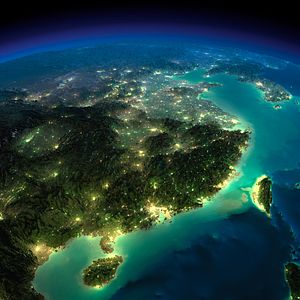Taiwan has a new president. Does this also mean the island will have a new future?
If the new future is understood as economic restructuring, an expanded social safety network, and improved social justice, as envisioned by the newly elected leader in her inaugural speech on May 20, then a qualified “yes” seems likely.
For many, if not most, supporters of Tsai Ing-wen, however, her resounding victory represents a clear mandate to reverse what they believe to be a growing trend of political accommodation toward Beijing in the past eight years. Presumably because of this electoral pressure, Tsai didn’t mention in her inaugural speech the “1992 Consensus,” an oral statement reportedly agreed upon by representatives from Beijing and Taipei in 1992. The consensus states that there is but one China and that “the political meaning of the ‘one China principle’ shall be interpreted by each side in a way it sees fit.”
Understandably, Chinese leaders seemed deeply upset by Tsai’s omission of the 1992 Consensus. In a statement released shortly after her speech, the head of the Taiwan Affairs Office of the State Council asserted that the new leader presented “an uncompleted answer sheet.”
Since Beijing has repeatedly made it clear that the 1992 Consensus is “a cornerstone of the peaceful development of cross-Strait relations,” and since the new Taiwanese president appears to have strong reservations about that consensus, a long shadow has been cast over the Taiwan Strait.
But while thinking ahead about uncertainties—and potentially tensions—in the next four years, Beijing should also think back: Why did a large majority of Taiwanese vote for her?
Admittedly, significant progress was made in cross-strait relations under Tsai’s predecessor, Ma Ying-jeou. Most notably, on November 7, 2015 Ma met with his mainland counterpart, Xi Jinping, in Singapore, the first meeting of its kind since 1949. That historic meeting is widely hailed as a landmark in cross-strait relations, paving the way for future summits and high-level political negotiations. Also, the past eight years—particularly after the signing of the Economic Cooperation Framework Agreement in 2010—have witnessed extraordinary growth in the flow of people, goods, and capital across the Strait.
From Beijing’s point of view, increasing economic interdependence should have induced Taiwanese voters to support the party of Ma (i.e., the Kuomintang or KMT), as opposed the party of Tsai (i.e., the Democratic Progressive Party or DPP, which has a track record of pro-independence). So what went wrong?
Alas, it would be terribly mistaken to assume that growing economic ties would naturally bring about more identification with mainland China among the Taiwanese. Doing business with China is one thing, but identifying with Beijing—particularly its political values and institutions—can be quite another. In fact, the “Occupy Central” protests in Hong Kong (whose economy is far more dependent on the mainland than that of Taiwan) amply demonstrated that identity—the question of “who are we?”—almost always trumps economic concerns. More importantly, unlike the identity of most residents in Hong Kong, which has been fundamentally shaped by the British colonial rule, the identity of many Taiwanese has been profoundly influenced by the island’s successful democratization.
Finally, there are always losers and winners in any economic relationship. While benefits from trade and investment are broadly spread, costs are narrowly concentrated. As a result, the losers often organize themselves into a vocal minority that can hijack the agenda of political leaders, as illustrated by the controversy surrounding the Cross-Strait Service Trade Agreement that led to the Sunflower Movement in 2014.
Whither Taiwan then?
In a 2014 National Interest article, John Mearsheimer analyzed Taiwan’s three options, namely, nuclearization, conventional deterrence, and the “Hong Kong strategy.” He dismissed the first as unfeasible, and the second as questionable (as it depends on long-term U.S. commitment to Taiwan’s defense). “But if China continues its impressive rise, Taiwan appears destined to become part of China,” he wrote of the third option.
The third option should sound like music to Beijing’s ears, but is it feasible?
To begin with, it is problematic to assume the continued rise of China. Many factors—domestic and international, economic and political—might disrupt China’s developmental trajectory. In fact, the Chinese economy has already entered a “new normal” characterized by significantly lower rates of growth.
Moreover, what happened in Hong Kong last year can illuminate how events might unfold in Taiwan should the island eventually reunite itself with China. Many Hong Kong residents apparently have become increasingly critical of “one country, two systems,” as evidenced by the Occupy Central protests. Also, as practiced now in Hong Kong, “one country, two systems” can be an easy scapegoat for economic woes or political frustrations that have little to do with Beijing. The same could happen to Taiwan should it choose—willingly or otherwise—the Hong Kong strategy. Given Taiwan’s much bigger land size, population, and economic clout, however, it will pose far bigger challenges for Chinese leaders.
In the end, it seems that keeping the status quo is the best option for both Beijing and Taipei, at least in the short term. In the long run, however, the people of Taiwan should find it easier to identify with Beijing if the latter embarks on a series of reforms that truly embody the letter and spirit of the “core socialist values” proposed by President Xi Jinping. After all, who wouldn’t be proud of being a member of a country that pursues “prosperity, democracy, civility, harmony, freedom, equality, justice, the rule of law, patriotism, dedication, integrity, and friendship?”

































